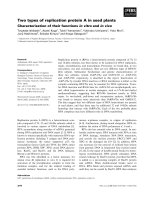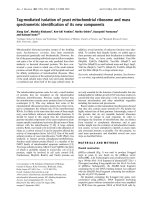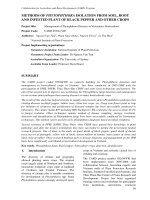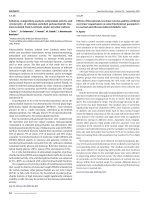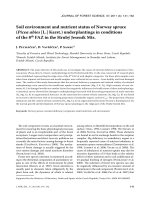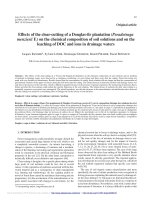Isolation of unculturable soil bacteria and finding of their antibiotic candidates
Bạn đang xem bản rút gọn của tài liệu. Xem và tải ngay bản đầy đủ của tài liệu tại đây (5.08 MB, 223 trang )
Dissertation for Degree of Doctor
Isolation Of Unculturable Soil Bacteria
And Finding Of Their Antibiotic Candidates
by
Nguyen Manh Tuan
Department of Life Science
Graduate School
Kyonggi University
(2017)
Isolation Of Unculturable Soil Bacteria
And Finding Of Their Antibiotic Candidates
by
Nguyen Manh Tuan
A dissertation submitted to the faculty of
the Graduate School in partial fulfillment of the requirements
for the degree of Doctor of Philosophy
Department of Life Science
Graduate School
Kyonggi University
December 2017
Approved the dissertation of Nguyen Manh Tuan
as qualified for the Degree of Doctor
of Philosophy
Chairman
Signature
Member
Signature
Member
Signature
Member
Signature
Member
Signature
December 2017
Graduate School of Kyonggi University
Contents
List of Tables ………………………………………………………………………….. vii
List of Figures …………………………………………………………………………. viii
Acknowledgement ............................................................................................................. x
Abstract ........................................................................................................................... xi
Chapter I. Modification Of Soil Extraction Method To Cultuvate Unculturable
Soil Bacteria .......................................................................................................... 1
1.1 Introduction ...................................................................................................... 1
1.2 Aims to Study ................................................................................................... 3
1.3 Material and method ......................................................................................... 4
1.3.1 Information of soil property used for the method ....................................... 4
1.3.2. Preparing new soil extraction (NSE) in 1 litre medium ............................. 4
1.3.3 Medium for isolation of soil bacteria .......................................................... 5
1.3.4 Soil sampling site and preparation of soil sample ....................................... 5
1.3.5 New developed method for isolation of previously unculturable soil
bacteria ....................................................................................................... 6
1.3.6 Traditional soil extract method ................................................................... 6
1.3.7 Modified transwell culture system method ................................................. 7
1.3.8 Bacterial genomic extraction and small-subunit rRNA (SSU rRNA)
amplification .............................................................................................. 7
1.3.9 Identify 16S rRNA gene sequences and accession numbers of 16S rRNA
gene sequenses ........................................................................................... 8
-i-
1.3.10 Parameter tools/software programs ........................................................... 8
1.3.11 Role of complex isolate medium compositions to grow previously
unculturable soil bacteria .......................................................................... 9
1.3.12 DNA extract from soil ............................................................................. 9
1.3.13 PCR amplification and pyrosequencing .................................................. 10
1.3.14 Analysis of pyrosequencing data ............................................................. 10
1.3.15 Determining and comparison of soil extract ingredients investigated .... 11
1.3.16 Sample preparation for simultaneous profiling analysis of amino acids,
organic acids and fatty acids in soil extract .............................................. 12
1.3.17 Gas chromatography-mass spectrometry ................................................ 12
1.3.18 Inorganic ingredients .............................................................................. 13
1.4 Results ............................................................................................................ 14
1.4.1 Shortage of previous methods and new method development .................. 14
1.4.2 Method validation through comparative analysis of organic/inorganic
compounds ............................................................................................... 19
1.4.3 Method validation through cultivability of unculturable bacteria ............. 21
1.4.4 Method validation through isolation rate of unculturable or new taxonomic
bacteria ..................................................................................................... 24
1.4.5 Method validation through taxonomic analysis ......................................... 29
1.5 Discussion ...................................................................................................... 33
Chapter II. Taxonomical Characterization Of Novel Taxa ............................ 37
2.1 A Rapid And Simple Method For Identifying Bacterial Polar Lipid
Components In Wet Biomass ............................................................................ 37
2.1.1 Introduction .............................................................................................. 37
- ii -
2.1.2 Aim to study .............................................................................................. 38
2.1.3 Material and method ................................................................................. 39
2.1.3.1 Organisms and growth conditions ....................................................... 39
2.1.3.2 Polar lipids extraction using the improved method .............................. 40
2.1.3.3 Polar lipids extraction using the the method of Minnikin et al.
(1984) .. ............................................................................................... 42
2.1.3.4 Polar lipids analysis ............................................................................. 42
2.1.4 Results and Discussions ............................................................................ 43
2.1.4.1 Polar lipid profiles of Microbacterium lacticum compared ................. 43
2.1.4.2 Polar lipid profiles of Rhodococcus koreensis compared .................... 44
2.1.4.3 Polar lipid profiles of Pseudomonas aeruginosa compared ................. 48
2.1.4.4 Polar lipid profiles of Streptomyces longwoodensis compared ........... 48
2.1.4.5 Polar lipid profiles of Novosphingobium capsulatum compared ......... 48
2.2 Description of Flavobacterium fulvus sp. nov., Flavobacterium pedocola sp.
nov., and Flavobacterium humicola sp. nov., novel members belong to the
family Flaviobacteriaceae, isolated from soil .................................................... 51
2.2.1 Introduction .............................................................................................. 51
2.2.2 Materials and method ................................................................................ 52
2.2.2.1 Sample and isolation of strains ............................................................ 52
2.2.2.2 Phenotypic characterisation ................................................................. 53
2.2.2.3 Genomic DNA isolate .......................................................................... 54
2.2.2.4 Phylogenetic analyses .......................................................................... 55
2.2.2.5 DNA–DNA hybridization (DDH) ....................................................... 56
2.2.2.6 G+C mol content ................................................................................. 58
2.2.2.7 Determining fatty acids components ................................................... 58
- iii -
2.2.2.8 Components of menaquinone and polar lipids .................................... 59
2.2.3 Results and discussion .............................................................................. 61
2.2.3.1 Results of comparision between new isolates and their relative
species ................................................................................................... 61
2.2.3.2 Description of novel isolates of genus Flavobacterium ....................... 72
Chapter III. Isolation And Characterization Of Novel Antibiotic
Candidates ......................................................................................................... 78
3.1 General Information ................................................................................... 78
3.1.1 Introduction ............................................................................................... 78
3.1.2 General background .................................................................................. 79
3.1.2.1 Term of antibiotic ................................................................................ 79
3.1.2.2 Antibiotic history ................................................................................. 80
3.1.2.3 How antibiotics work to kill bacteria ................................................... 82
3.1.2.4 Current problems with known drugs .................................................... 86
3.1.2.5 Mechanisms of drug resistance ............................................................ 88
3.1.3 Goal of this study ...................................................................................... 91
3.2 Screening of Antibiotic-Producing Bacteria Isolated From Soils ........... 92
3.2.1 Materials and methods .............................................................................. 92
3.2.1.1 Soil sample .......................................................................................... 92
3.2.1.2 Isolation of microorganisms ................................................................ 92
3.2.1.3 For members of Actinobacteria ........................................................... 92
3.2.1.4 Modified culture method ..................................................................... 93
3.2.2 Screening antibiotic-producing bacteria .................................................. 93
- iv -
3.2.2.1 Microorganisms used to test ................................................................ 93
3.2.2.2 Assay of antimicrooganisms activities ................................................. 94
3.2.2.3 Identification of 16S rRNA gene analysis ............................................ 94
3.2.3 Results and discussion .............................................................................. 94
3.2.3.1 Isolation of anti-microoganisms .......................................................... 94
3.2.3.2 Finding of the best strain to extract antibiotics .................................. 101
3.3 Characteristic Of Antibiotic Derived A Novel Species of Genus
Sphingobium ..................................................................................................... 104
3.3.1 Material and method ............................................................................... 104
3.3.1.1 Fermentation and extraction of antibiotic .......................................... 104
3.3.1.2 Purification of antibiotic extraction by silica gel column
chromatography ................................................................................... 105
3.3.1.3 Collection of individual compound by Prep-HPLC ........................... 105
3.3.1.4 Minimum inhibitory concentration (MIC) test .................................. 107
3.3.2 Results and discussion ............................................................................ 108
3.3.2.1 Major descriptions of strain UCM-25 ................................................ 108
3.3.2.2 Extraction, purification, separation of antibiotics ............................. 110
3.3.2.3 Thin-Layer Chromatography (TLC) assay ........................................ 110
3.3.2.4 Collecting individual compound ........................................................ 112
3.3.2.5 Minimal Inhibitory Concentration (M.I.C) test .................................. 116
3.4 An Antibiotic Producing Streptomyces Species Kills Drug Resistant
Pathogens ......................................................................................................... 118
3.4.1 Material and methods .............................................................................. 118
3.4.2 Results and Discussion ............................................................................ 119
-v-
3.4.2.1 Major information for strain T1317-0309 ......................................... 119
3.4.2.2 Screening of fractions collected by Prep-HPLC ................................ 126
3.4.2.3 Minimal Inhibitory Concentration (M.I.C) test ................................. 127
Chapter IV. General Conclusion ................................................................... 131
4.1 Modification Of Soil Extraction Method ...................................................... 131
4.2 Taxonomical Characterization Of Novel Taxa ............................................. 132
4.3 Isolation And Characterization Of Novel Antibiotic Candidates ................. 133
Reference .......................................................................................................... 135
Appendix ........................................................................................................... 167
Abstract in Korean ........................................................................................... 202
- vi -
List of Table
Table 1.
Brief summary comparision of results by methods determined ................... 15
Table 2.
List of soil extract components defined a new way and general
approaches .................................................................................................... 17
Table 3.
List of bacterial isolates used for evaluating new soil extract (NSE) ........... 21
Table 4.
Comparision of convenient methods for extracting bacterial polar lipids .... 49
Table 5.
Comparision of distinct phenotypic characteristics between four isolate strains
and their type strains of the most related species of the genus
Flavobacterium ............................................................................................ 63
Table 6.
Cellular fatty acid composition (%) of four isolate strains and the type strains
of related species of the genus Flavobacterium ............................................ 67
Table 7.
Antibiotic pathways to inhibit microoganisms ............................................. 83
Table 8.
List of isolating bacterial soils that showed target microoganisms .............. 95
Table 9.
Antibiotic extract activity of inhibition of target microoganisms using paper
disc ............................................................................................................. 102
Table 10. Activities of each fraction that are collected by Prep-HPLC, which inhibit
target pathogens (Inhibition zone in mm) ................................................... 113
Table 11. Minimal inhibitory concentration (MIC in μg ml-1) values of Fr-1 and Fr2 ................................................................................................................. 117
Table 12. Cultural characteristics of Streptomyces sp. T1317-0309 on various media
tested at 28oC for 21 days ........................................................................... 120
Table 13. Result of identification of strain T1317-0309 based on 16S rRNA gene
sequencing using the eztaxon-e .................................................................. 123
Table 14. Antibacterial activities of the Fr-5 collected from Streptomyces sp. T13170309 .......................................................................................................... 129
- vii -
List of Figure
Fig 1. An impact of various factors on cultivation of uncultured soil bacteria ....... 20
Fig 2. Achievement of phenotypic diversity of species isolated through soil
samples ........................................................................................................... 23
Fig 3.
Abundance of bacteria in the soil samples defined by pyrosequencing and a new
method ............................................................................................................ 28
Fig 4.
Identifing phenotypic diversity of isolates through analysis of 16S rRNA gene
sequence ......................................................................................................... 32
Fig 5.
Brief proceduces for extraction and purification of polar lipids ..................... 41
Fig 6.
Polar lipid profiles determined using the two methods ................................. 46
Fig 7.
Neighbour-joiningtree, based on 16S rRNA gene sequencing, showing the
position of strains UCM-R15T, UCM-R21, UCM-R36T and UCM-46T , which
are closely related species of the genus Flavobacterium .............................. 62
Fig 8.
Polar lipid profile of strains UCM-R15T, UCM-R36T, and UCM-46T after twodimensional chromatography and staining with 5 % molybdatophosphoric acid
at 180 oC for 30 min ....................................................................................... 69
Fig 9.
Scanning electron micrograph showing the cells morphology of strains UCMR15T, UCM-R36T, and UCM-46T grown on R2A medium. Bars, 0.5 µm ..... 71
Fig 10. Fleming and his penicillin discovery on the original agar plate ..................... 81
Fig 11. Antibiotics and its antibiotic resistance reported ........................................... 87
Fig 12. Machanism of antibiotic resistance through pathway of efflux pump ........... 89
Fig 13. Distribution (number among total 44 strains) of the strains showing activities
against the targets .......................................................................................... 99
Fig 14. Relative distribution of the active strains in the level of bacterial genus, showing
antimicrobial and antifugal activities against the target test ......................... 101
Fig 15. Main steps for extracting antibiotic and further analysis ............................. 106
- viii -
Fig 16. Neighbor-joining phylogeny of strain UCM-25 based on near full-length 16S
rRNA gene sequences .................................................................................. 109
Fig 17. Thin layer chromatography for compound analysis .................................... 111
Fig 18. Collecting individual fraction via a Prep-HPLC system ............................. 112
Fig 19. Inhibition zone of these fractions collected killing microoganisms test ...... 114
Fig 20. Thin layer chromatography for compound analysis of T1317-0309 ........... 121
Fig 21. A neighbour-joining phylogenetic tree of strain T1317-0309 with related species
in genus Streptomyces ................................................................................. 125
Fig 22. Profile of secondary metabolism extracted from the fermentation
supernatant ................................................................................................... 126
Fig 23. Zone of inhibtion of these fractions collected showing activity to kill
microoganisms tested ................................................................................... 126
- ix -
Acknowledgement
First, I’m really pleased to Prof. Jaisoo Kim, who gave me an especial opportunity to
study and research in South Korea, as well as great supports for researches and my family
during living in Republic of Korea.
I would like to thank you all of Professors at the Department of Life Science, Kyonggi
University: Prof. Byung-Sun Yoon, Prof. Sang Seob Lee, Prof. Dong-Soo Kong, Prof.
Byung-Sun Yoo, Prof. Ok-Min Lee, and Prof. Seong-Ho Ghil for these suggestions to
improve my researches. I would be glad to Dr. Seung Jae Won, who suggested solving my
problems during study, as well as his interest in my family life in Korea. I am also grateful
to the doctoral communitte members: Prof. Seung-Woo Jeong (Kunsan National University)
and Prof. Song-Bae Kim (Seoul National University) for their valuable suggestions to
improve my dissertation. An especial thank you to Prof. Seung-Woon Myung (Department
of Chemistry, Kyonggi University) and Prof. Man-Jeong Paik (College of Pharmacy and
Research Institute of Life and Pharmaceutical Sciences, Sunchon National University) for
their support during my study.
To complete my doctoral degree, I received special encouragement from my family
and friends that helped me through difficult time, without them my life is certainly very
difficult. I’m thankful to all of lab members, classmates and Korean students always help
me in study and research.
December 2017, Republic of Korea
Nguyen Manh Tuan, Ph.D Student
-x-
Abstract
Surely, there are so many unknown metabolic potentials of uncultured soil bacteria. A
lot of methods have been established by various approaches to explore unculturable soil
bacteria. But all of these methods have a common obstacle which is limitation of the solid
medium to obtain large groups of not-yet cultivated species. This study is simply designed
to discover more unculturable soil bacteria in aerobic conditions through a new soil extract
(NSE) derived from soil, the "bacterial home". NSE devloped in this study is different from
the existing methods since this method uses a mixuture of water and methanol instead of
water only to extract soil chemical compounds. Moreover, this new method makes easier
to perform and reduces working hours than the existing cultivation methods for
unculturable soil bacteria, and also this method can be working well without enrichment
and even combining with traditional media.
NSE contains essential ingredients required for soil microorganisms including
chemoorganotrophic, chemolithotrophic, and heterotrophic bacteria based on our anlytical
results. By combination with several active components we chose, a new medium, called
ISEM (Intentive Soil Extraction Medium for unculturable soil bacteria), was created and
showed successful cultivation of bacterial strains involved in 7 phyla: approximately 49%
and 55% of the total isolates (n=258) was belonging to the previously uncultured bacteria
and new taxonomic candidates including species, genus and even family level, repectively.
Therefore, we expect that this discovery could open up a new avenue to explore unknown
mechanisms and new knowledge through sussessful cultivation of a number of bacteria
hidden in various soil environments.
Although the use of freeze-dried cells to determine polar lipid components have
successfully been used, several methods have been developed based on wet cells. However,
wet cell methods showed limitation with narrow scope in applications due to non-polarity
of extracted phospholipids. In this study, wet biomasses of five species of Gram-positive
- xi -
and Gam-negative bacteria including Microbacterium lacticum, Rhodococcus koreensis,
Pseudomonas aeruginosa, Streptomyces longwoodensis and Novosphingobium capsulatum
were used to analyze lipid components, revealing equal quality compared to the most
applied procedure with wet biomasses except a few minor spots. Moreover, the improved
method also ensures simplicity of lipid extraction.
Four Gram-staining negative, non-endospore-forming, non- non-motile strains were
found soil in Yuseong-gu, Daejeon, South Korea. Through analysis of these 16S rRNA gene
sequences suggested they should be belonged the genus Flavobacterium; strain UCM-R15T
and UCM-R21 most closely related to F. enshiense DK69T (97.38-97.46 %), F.
saliperosum S13T (96.28-96.35 %), F. suncheonense GH29-5T (96.28-96.35 %), F.
limnosediminis JC2902T (96.14-96.22 %), F. cauense R2A-7T (95.17-95.67 %), and F.
columnare IFO 15943T (94-88-95.25 %); for strain UCM-R36T showed 97.53 % to F.
suncheonense GH29-5T, 96.57 % to F. enshiense DK69T, 96.43 % to F. limnosediminis
JC2902T, 96.29 % to F. saliperosum S13T, 95.74 % to F. cauense R2A-7T; UCM-46T shared
closely related to F. suncheonense GH29-5T (98.27 %), F. cauense R2A-7T (96.06 %), F.
enshiense DK69T (95.5 %), F. saliperosum S13T (95.44 %), and F. limnosediminis JC2902T
(95.44 %). All four strain cannot reduce/digest nitrate or urea. Major menaquinone MK-6
was detected in all isolate strains. Fatty acid as C15:0 iso, C17:0 iso 3-OH, C15:1 iso G, summed
feature 9 (C17:1 iso ω7c and/or C16:0 10-methyl, C15:0 iso 3-OH, C15:0 anteiso, and C16:0 iso
were found in all the strains. Phosphatidylethanolamine was found in three strains as major
polar lipid; phosphatidylserine in strain UCM-R15T, UCM-R36T, not UCM-46T; and
phosphatidylmonomethylethanolamine was only occurred in strain UCM-R15T; moreover
unidentified polars (L2 or L3) were appeared at 160-180 °C after 15 min, while these
remaining spots were fast appeared. Genomic DNA G+C content of strains UCM-R15T,
UCM-R21, UCM-R36T, UCM-46T was 35.3, 36.2, 39.0, and 38.4 mol%, respectively. The
results of DNA-DNA hybridizations between our strains and comparison strains were lower
than 70 % limit off; combining with their physiological and biochemical characteristics,
we suggest that three strains represent novel members within the genus Flavobacterium,
- xii -
for which the name Flavobacterium fulvus sp. nov. is proposed, the type strain is UCMR15T (=KACC 18666T =NBRC 111764T); Flavobacterium pedocola sp. nov. is proposed,
the type strain is UCM-R36T (=KACC 18668T =NBRC 111765T); Flavobacterium
humicola sp. nov. is proposed, the type strain is UCM-46T (=KACC 18575T =NBRC
111657T).
More than 100 soil samples were collected from many forests in Korea during 2013.
We found 43 strains from more than 3,000 isolates, which showed antimicrobial activity
against Paenibacillus larvae as an agent of American Foulbrood (AFB) as well as common
microbial human pathogens such as Bacillus subtilis, Staphylococcus aureus, Escherichia
coli, Candida albicans and Aspergillus niger. On the basis of 16S rRNA gene sequence
analysis, they belong to 12 genera (mostly actinobacteria): Streptomyces (28), Kitasospora
(4), Bacillus (2), Streptacidiphilus, Amycolatopsis, Paenibacillus, Promicromonospora,
Rhodococcus, Pseudomonas, Burkholderia, Undibacterium and Actinomadura. Among
them, Streptomyces species are dominant (28/43 strains, 65.12%). Burkholderia and
Undibacterium spp. were reported first as antimicrobial agents, especially against Grampositive bacteria.
Among them, our work focused on strain UCM-25 that is belong to genus
Sphingobium, which is no antibiotic-producing report in this genus so far. Strain UCM-25T
was classified as a novel species of genus Sphingobium, for which name Sphingobium
aromaticivorans. Fr-1 and Fr-2 derived from this new species as prep-HPLC fractions of
culture extractant can inhibit Bacillus subtilis KEMB 51201-001 (16; 64 μg ml-1, MIC
respectively), Staphylococcus aureus KEMB 4659 (16; 64 μg ml-1), Pseudomonas
aeruginosa KACC 10185 (16; 128 μg ml-1), Escherichia coli KEMB 212-234 (32; 128 μg
ml-1), Paenibacillus larvae KACC 14031 (16; 32 μg ml-1), Streptococcus agalactiae
CCARM 4504 (64; 128 μg ml-1), Streptococcus pyogenes CCARM 4520 (32; 256 μg ml-1),
Enterococcus faecalis CCARM 5168 (128; 128 μg ml-1), and Enterococcus faecalis
CCARM 5171 (64; 128 μg ml-1).
- xiii -
Strain T1317-0309 was isolated from a soil sample collected in South Korea, showing
strong activity against some Gram-positive bacteria, but not Gram-negative bacteria, yeast
and fungus. Based on the analysis of 16S rRNA gene sequence, the strain was involved in
genus Streptomyces. Fr-5 was collected and purified among five fractions through a prepHPLC and detected at 280 nm. Fr-5 was not able to be dissolved in water, but well in
methanol, ethanol, ethyl acetate. Based on TLC analysis and order of prep-HPLC peaks,
Fr-5 seemed to be non-polar property in its molecule. The compound from Fr-5 inhibited
Gram-positive bacteria including antibiotic resistant-bacteria with its MIC values (range of
0.125~4 μg per ml), such as Bacillus subtilis KEMB 51201-001 (0.5 μg per ml), Bacillus
anthracis KEMB 211-146 (0.5), Staphylococcus aureus KEMB 4659 (1), Paenibacillus
larvae KACC 14031 (0.125), Streptococcus agalactiae CCARM 4504 (0.5), Streptococcus
pyogenes CCARM 4520 (0.5), Enterococcus faecalis CCARM 5168 (0.5), Enterococcus
faecalis CCARM 5171 (0.5), Enterococci CCARM 5025 (0.5), Enterococci CCARM 5024
(0.5), Staphylococcus epidermidis KACC 13234 (1), methicillin-resistant Staphylococcus
aureus CCARM 3095 (0.5), methicillin-resistant Staphylococcus aureus CCARM 3192 (4),
methicillin-resistant Staphylococcus aureus CCARM 3155 (1.25), methicillin-resistant
Staphylococcus aureus CCARM 3710 (1.25), methicillin-resistant Staphylococcus aureus
CCARM 3A041 (1.25), and Propionibacterium acnes subsp. acnes KCTC 3314 (0.25).
These results indicates that the antibiotic candidate isolated and purified in this study can
be useful as an antibiotic against multi-antibiotic resistant pathogens because of its lower
MIC values against many antibiotic-resistant pathogens than ones of commercial
antibiotics.
- xiv -
Chapter I. Modification Of Soil Extraction Method
To Cultuvate Unculturable Soil Bacteria
1.1 Introduction
Since the method of solid medium culture have been established, currently we have
benefited greatly from secondary metabolites of microorganism, which were cultured in
the laboratories. For example: the first antibiotic as named Penicillin derived from
Penicillium in 1928 (Fleming, 1929), after that, many new antibiotics were found, which
support to prevent the disease effectively.
Through molecular tools revealed that prokaryotic species are much more diverse and
abundant in soil, they contain a lot of unexplored potential metabolites (Doroghazi et al.,
2014; Lewis et al., 2010; Ling et al., 2015; Milshteyn et al., 2014). Lack of complex
factors/conditions in laboratory conditions were given for these bacteria that have not been
isolated yet (Stewart, 2012; Vartoukian et al., 2010). Since, the term of "unculturable
bacteria" published, passing nearly a decade, several methods have been developed. They
were things to be become more simply seeming to "bring bacteria" from nature to
laboratory by creating artificial media/conditions similar to natural environment through
modification of growth media's components (Vartoukian et al., 2010), modification of
growth conditions (Stevenson et al., 2004), using inorganic compounds or metals as
electrodes (Hobbie & Hobbie, 2013; Pierra et al., 2015), various factors (Davis et al., 2005)
and helper bacteria (Burmølle et al., 2009; D'Onofrio et al., 2010).
Furthermore, sophisticated techniques were also developed as iChip for an in situ
cultivation (Nichols et al., 2010), micro-bioreactor (Amanullah et al., 2010), optical
tweezers (Zhang and Liu, 2008), or micro-manipulator (Fröhlich and König, 2000), etc.,
allowing to pick up individual cells in soil samples. Hence a new artificial advanced
-1-
medium for maintaining these cells is requested. Although the most power tool developed
recently allows to know any metabolic diversity of microorganisms without isolated
species by the single-cell sequencing, however, it still has many unresolved challenges in
the near future due to limitation of cultivation (Gawad et al., 2016; Heath et al., 2016; Yuan
et al., 2017; Liu & Trapnell, 2016; Vallejos et al., 2017; Mocali & Benedetti, 2010; Daniel,
2005; Medema & Fischbach, 2015).
Although scientists can be successful to enrich slow-growing microorganisms through
using diffusion chamber (Bollmann et al., 2007; Kaeberlein et al., 2002) or soil substrate
membrane (Ferrari et al., 2005), however, the number of bacteria have been isolated on
agar plates stopped at restriction level. So far, we have only known less than 1% of the total
soil bacteria. Without cultivation, there is no way to detect and identify novel organisms,
to gain any phenotypic and functional information, and to determine the functions of
unknown genes (Pham and Kim, 2012).
A big question is given, what is the most important factor to cultivate uncultured
bacteria? Which is still lack of artificial media in laboratory? In this study, we try to answer
that question, with a simple culture method developed without specific supplies through
successful new bacterial isolates.
Definition of uncultured bacteria and major reasons for that:
There are too many bacteria can’t grow under laboratories, especially on agar plates
using current commercial media for example nutrient, R2A, trypticase soy agar, LuriaBertani, etc. These bacteria are called uncultured bacteria or not-yet-cultivated bacteria.
By the above mentioned reasons, factors such as temperature, pH, nutrient specificity
and oxygen levels have been shown to affect isolation (Kopke et al., 2005).
Relation between bateriocins, antibacterial agents and species living together, they are
present in natural habitats, but may be absent in artificial media (Tamaki et al., 2005).
-2-
Lack of knowledge about bacterial biofilms, as well as their interactions among
species (Hall-Stoodley et al., 2004; Stoodley et al., 2002; Marsh, 2005; Ten Cate, 2006;
Belenguer et al., 2006; Mikx and Van der Hoeven, 1975; Davey, 2008).
Structure of the bacterial community and survival, which maybe relative to quorumsensing mechanism (De Kievit et al., 2001; Konaklieva and Plotkin, 2006; Ten Cate, 2006).
Shortage of molecular signals, which are only present in natural environments, have
resisted culture in laboratories (Lewis, 2007, Nichols et al., 2008; Barcina et al., 1990;
Colwell, 2000).
Together with other reasons leading to scientists have been unable to reach the group.
1.2 Aims to Study
(i) The new method developed is more effective than the current method for group of
unculturable soil bacteria.
(ii) Simple, easy to apply for basic investment laboratories without any special
conditions.
-3-
1.3 Material and method
1.3.1 Information of soil property used for the method
Rhizosphere soil was collected at Kyonggi University (154-42 Gwanggyosan-ro, Iuidong, Yeongtong-gu, Suwon, Gyeonggi-do, South Korea; 37o30'04''75'''N, 127o03'58''26'''E)
during June 2016, where has diverse vegetation. Fresh soil was dried at room temperature
for 24 h, then discarded any plant debris, gravel and rock by a sieve with ahole of 0.2 mm.
Next, the soil was dried at 110oC for 24 h, then cool it at room temperature to determine
physical properties of soil. Soil contain approximately 78% sand, 17% silt and 5% clay. pH
of soil ~5.7 that was defined directly from fresh soil.
1.3.2. Preparing new soil extraction (NSE) in 1 litre medium
Approximately, 1000 g of the dry soil sieve at room temperature was divided into two
equal parts (500 g soil for each) in a 2L flask, then was mixed with 1.3 litre of 80% methanol
(#494291, grade methanol, Sigma Aldrich) that is created in deionized water, incubated
overnight at room temperature (should be below than 25oC), tranfferred supernatant to a
new flask. Secondly, 1.3 liter of 80% methanol was added in the soil, mixed well for an
hour. Combining the two supernatant, filtered through WhatmanTM paper (#1001-150,
150mm, GE healthcare UK). Methanol was evaporated with N2 (~ 40°C). The NSE was
adjusted the final volume of 200ml deionized water, was sterilized through a 0.22 µm filter
membranes nitrocellulose (#GSWP04700, Merck Millipore Ltd.) using a vacuum pump.
The pure supernatant was passed through via a 0.2 µm PVDF membrane (#WHA67791302,
Sigma Aldrich) if necessary to make sure none of bacteria in the soil extraction, the pure
NSE was storedin dark schott duran bottle at 4oC using within one week.
-4-
1.3.3 Medium for isolation of soil bacteria
Medium component including 0.23 g KH2PO4, 0.23 g K2HPO4, 0.23 g MgSO4•7H2O,
0.33 g NH4NO3, 0.25 g NaHCO3 as a group of mineral salts, 15 g agar in 1 litre water,
sterilized at 121oC for 15 min. Then, adding final volume of 5 mg of each various D-amino
acids (D-valine, D-methionine, D-leucine, D-phenylalanine, D-threonine and Dtryptophan), 1 ml vitamin B (vitamin stock solution containing 50 mg each thiamine
hydrochloride, riboflavin, niacin, pyridoxine HCl, inositol, calcium pantothenate and βaminobenzoic acid and 25 mg biotin in 100 ml distilled water, sterilized through a 0.2 µm
syringe filter, which was kept at 4oC in dark schott duran using within one month), 0.2 litre
of NSE, 2 mL of selenite-tungstate solution (Tschech & Pfennig, 1984), and 2 mL of trace
element SL-10 (Widdel et al., 1983). The final volume of various mixed components is 1L,
pH is ranged in 6.8±0.2. Complex medium component was called Intentive Soil Extraction
Medium (ISEM). The medium should be prepared freshly and use within a week. In this
study, we used petri dish with Φ 150 x 20 mm (SPL Life Science Co., Ltd, South Korea).
The bigger dish allows for increased separation of colonies at the high dilution
concentrations during isolation.
1.3.4 Soil sampling site and preparation of soil sample
Three soil samples were taken in South Korea during June 2016, included in Ansan as
named sample A (Sangnok-gu, Ansan-si, Suwon, Gyeonggi-do; 37o31'56''N, 126o86'65''E);
in Buksu-dong/sample B (Buksu-dong, Paldal-gu, Suwon, Gyeonggi-do; 37o28'59''N,
127o01'70''E); and in Seoul/sample S (Itaewon-ro, Yongsan-gu, Seoul; 37o53'51''N,
126o97'44''E). For each sample, approximately 10 g soil atten different locations in 150
meters in diameterwere collected and mixed well together. The sample was passed through
0.1 mm sieve, isolated/enriched directly for the three methods. Taking the 25 g sieved soil
sample was mixed well in 250 mL sterile saline (0.9% NaCl, w/v) stirring within 15 min,
allowed to sediment. Then, 100 µl of suspension was transferred into the transwell insert
-5-
for the modified method that was shown in detail the next part. Both of remaining the
methods, six folds were preprared in the 0.9% NaCl, were ready for next step.
1.3.5 New developed method for isolation of previously unculturable soil
bacteria
About 100 µL of each the dilution (10-2 to 10-6) was spread onto three agar plates of
ISEM (to ensure uniformly distributed suspension on the surface of the medium, 100 μL of
each the dilution plus 100 μL of ISEM liquid is recommended). These agar plates were
incubated at 25oC for 6 weeks. A few colonies were appeared after one week incubation.
The number of directly visual colonies was increased after 2 weeks, tiny colonies were
picked up, streaking onto fresh ISEM until getting pure morphological colonies. Cells on
the fresh ISEM usually require at least a week to grow. Actually, the unculturable bacteria
are generally weak growth, thus in some cases pure colony is activated in ISEM broth with
shaking from one to two weeks before transferring to the agar plate. Unusually,
unculturable bacteria need much time to grow therefore, in some case, tiny colonies were
cultivated on ISEM liquid until the culture will becomce opaque, then it was transferred
onto the agar plates.
1.3.6 Traditional soil extract method
About 1000 g air-dried soil in 1.3 L of deionized water was be autoclaving at 121oC
for an hour, allowed to cool. The supernatant was filtered by using the WhatmanTM paper
before centrifuge using 500 ml of bottle at 5009 ×g, 30 min, at room temperature. Finally,
obtaining 1L of the supernatant (TSE). A soil extract agar was enhanced by supplement 34
of 0.04% K2HPO4, 0.005% MgSO4.7H2O, 0.01% NaCl, 0.001% FeCl3, 0.05% tryptone,
0.05% yeast extract, 1.5% agar in 1 L the soil extract liquid, the final pH of 6.8. Then, 100
µL of the each fold was dispersed onto three soil extract agar plates, cultivated at 25oC for
6 weeks. Appearing colonies were re-streak until getting pure colony on the medium.
-6-
1.3.7 Modified transwell culture system method
Approximately, addition of 3 g of the soil sample in the well of a transwell plate, then
3 mL R2A medium (#MB-R2230, MB Cell, South Korea; 3.15 g of the powder in 1L
distilled water) was supplemented into the soil-wells, placing 0.4 µm polycarbonate
membrane (#35006, SPLInsert™ Hanging, SPL Life Sciences) as the insert on the wet soil.
Then 100 µL of the suspension and 1ml R2A medium were inoculated into the insert. The
transwell culture system was covered by parafilm tape to prevent evaporation. The system
was shaked at 120 r.p.m, 25oC for 4 weeks. After that, seven folds in R2A medium were
established, 100 µL of each dilution was spread on three R2A agar plates that were
incubated at 25oC for 6 weeks. Colonies were subcultured on R2A medium to get individual
colony.
1.3.8 Bacterial genomic extraction and small-subunit rRNA (SSU rRNA)
amplification
Pure individual colonies were extracted genomic DNA using GenElute™ Bacterial
Genomic DNA Kit (#NA2110, Sigma aldrich). Two universal primers 27FAGAGTTTGATCMTGGCTCAG and 1492R-TACGGYTACCTTGTTACGACTT were
used to amplify SSU rRNA. PCR compositions and running conditions were carried out
following previously study (Klindworth et al., 2013). Briefly, 80ng DNA template, 0.3
mg/mL Bovine Serum Albumin (#B8667, Sigma Aldrich), 250 µM dTNP (#R1121,
Thermo Fisher Scientific), 0.02 U Phusion DNA Polymerases (#F530S, Thermo Fisher
Scientific), 5× Phusion HF Buffer presence of 1.5 mM MgCl2 (#M8787, Sigma Aldrich),
0.5 mM of each primer in the total 50 µL. The PCR reaction was performed at 95oC for
5min: initial denaturation, 25 cycles repeated of: denaturation 95oC for 40s), 2 min for
annealing at 55oC and extension at 72oC for 1 min. Final extension step at 72oC for 7 min.
The PCR product was examined in 1.3% gel agarose, stored at -20 oC within one month for
further analysis. Sequencing was performed with an Applied Biosystems 3730XL DNA
-7-
analyser using a Big Dye terminator cycle sequencing kit v.3.1 (Applied Biosystems). A
nearly complete sequence was compiled with SeqMan software (DNASTAR Inc.).
1.3.9 Identify 16S rRNA gene sequences and accession numbers of 16S
rRNA gene sequenses
Near-full-length 16S rRNA sequences were identified, calculating similarity to valid
species through the EzTaxon Database Update ( to
compare with published unculturable gene sequences via the nucleotide BLAST in NCBI:
In this study, based on full 16S rRNA similarity to valid
published species, we were temporary division four, among candidates of novel species are
defined through comparison of 16S rRNA similarity at the threshold of 98.7% (Browne et
al., 2016), the 95.3~90.0% novel genus level (Yarza et al., 2008), and novel family level at
off limit lower than 90.0%. These sequences for candidates of uncultured or novel species
or new genera or family were released in the GenBank database that were listed in the
Supplementary Tables; for isolates without accession numbers are ready if requested.
1.3.10 Parameter tools/software programs
CLUSTAL X2.1, BioEdit, MEGA7.0.21 and the Kimura’s two-parameter model with
bootstrap values based on 1000 replications to build topology phylogenetic tree based on
full 16S rRNA gene sequences.
-8-


